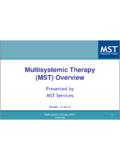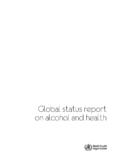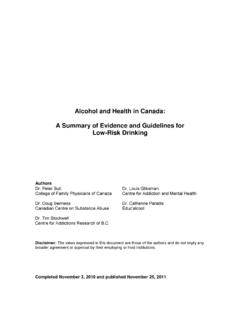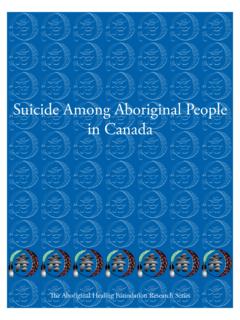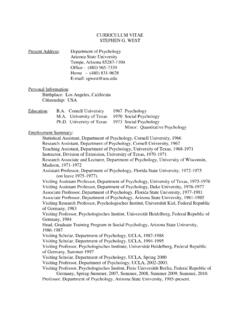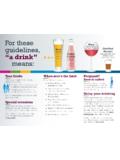Transcription of elder abuse - Canadian Resource Centre for Victims of Crime
1 June 2006 1 elder abuse Prepared by the Canadian Resource Centre for Victims of Crime Introduction Older people today are more visible, more active and more independent than ever before. However, as the population of older Canadians grows, so does the hidden problem of elder abuse . Moreover, as the population of baby boomers1 grows older, the prevalence of elder abuse is expected to escalate. Each year hundreds of thousands of older persons are abused, neglected and exploited by their family members and others2. elder abuse is consistently unreported for various reasons, with dependency upon the abuser being the main reason. It is also difficult to put an end to unless people recognize the abuse and let someone know it is happening.
2 Older people who experience abuse may suffer serious health implications, as well as various psychological disturbances, including heightened stress levels, anxiety, depression, and helplessness. What is elder abuse ? elder abuse is any form of mistreatment, action or inaction by any individual or institution, which causes harm, threatens harm or jeopardizes the health or well being of an older person. elder abuse takes on several forms according to the type of harm resulting. Physical abuse using physical force that results in physical injury, pain or impairment. This includes assault, battery or restraint. Sexual abuse nonconsensual sexual contact of any kind with an older person.
3 Emotional/Psychological abuse verbal assaults, humiliation, threats, harassment, intimidation, or other abusive behaviours which result in emotional disturbances of the victim. It also includes the willful infliction of mental or emotional anguish by threat, humiliation or other verbal or nonverbal conduct. Financial Exploitation the misuse or withholding of an older adult s resources by another, to the older adult s disadvantage. It also includes illegal or improper use of an older person s funds, property or resources. 1 Canadians born in the years of 1946-1964 2 Poirer, D. & Poirer, N. (1999) Older adults personal relationship. Why is it so difficult to combat elder abuse and, in particular, financial exploitation of the elderly: Final Report.
4 Law Commission of Canada research paper. #p1 June 2006 2 Neglect failure to provide for personal care (food, shelter, medical care, social contact) or forceful confinement or restraint of the older adult (either intentionally or unintentionally). Domestic Violence escalating pattern of violence by an intimate partner where violence is used to exercise power and control. Prevalence In Canada, a national telephone survey in 1990 revealed that 4% or 100,000 elderly persons living in dwellings have recently suffered from one or more events of abuse3. The General Social Survey issued in 1999 showed that approximately 7% of elderly have suffered some form of abuse by an adult child, caregiver or spouse during a five-year period.
5 It is believed that as many as 10% of the elderly living in the community and using community-based services are subjected to Moreover, elder abuse shows an escalating pattern: from 1986 to 1998 elder abuse has increased by almost 20% Research studies also show that only 1 in 4 cases of elder abuse are Psychological and financial abuses are listed as the most common types of abuse , both reported and unreported. Physical abuse is third most prevalent type of abuse , generally perpetrated by spouses. Who is victimized? Any person aged 65 and older may be a victim of elder abuse regardless of economic, social, ethnic or cultural background. Victims come from all walks of life; they may be male or female; frail or in good health.
6 The most typical victim is described to be a female of the average age of 72, living with the abuser. Who is the abuser? The abuser is typically a family member taking care of the elderly person, staffing personnel from the institution where the elderly person is living, or a spouse. It is not uncommon for the abuser to be a friend or a person whom the elderly is dependent 3 Podnieks, E., Pillemer, K., Nicholson, , Shillington, T. & Frizzel, A. (1990) National Survey on abuse of the Elderly in Canada, Toronto 4 Health Canada (2000), abuse and Neglect of Older Adults: a Discussion Paper 5 Statistics Canada (1999),General Social Survey 6 Statistics Canada (1999),General Social Survey June 2006 3 upon, as they are in the position of power over the senior.
7 Psychological problems are often present, such as abusive or violent patterns and psychopathology in the personality of a caregiver who abuses the elderly. Poor adjustment is a contributor as well; inability to sustain employment, failing relationships, and anti-social behavior being main signs of poor adjustment. Difficulties coping with stress brought by caring for the older person may also contribute to the abuse . However, no matter the factors involved, abusers make a choice to be abusive. Why abuse happens There are many different reasons why abuse might occur and it is important to note that every instance is unique. Some factors that have been identified include: - A history of abuse between family members, for example, spousal abuse becomes elder abuse , or abused children become abused caregivers to elderly parents.
8 - Dependency, for example, the elderly person becomes dependent on family members, or someone is dependent upon the elderly person for money or housing. - Stress might be caused by a number of factors such as mental or physical illness, financial pressures, lack of support systems, lack of choice for accommodation for an elderly person, or fear of one's own aging. - Alcohol or drug use. - Greed. - Lack of knowledge about the degree of care and needs of an elderly person. - Lack of respect given to elderly people in a society that values youth, self-reliance, and energy. - Lack of professional awareness about the problem of elder abuse , so that it might continue - Institutional issues: poor working conditions, work overload, low salaries, inadequate staff training and supervision, and prejudiced attitudes.
9 - Frailty of an elderly person increases the chance of being abused. Risk factors for abuse 7 Canadian Legal FAQs, information retrieved from: June 2006 4 - The senior citizen is socially isolated, especially due to physical disabilities or impairment. - Victim suffers from some form of mental impairment, for example, dementia. - Older adult has substance abuse problems, for example, alcohol or medication. Signs of abuse , for example, forced drug injection, may get misidentified as signs of voluntary substance use. Alcohol abuse can also impede access to services. - Language barriers for the elderly person. - Cultural barriers for the elderly person. - Being a woman; women are at greater risk of being victimized.
10 Signs of abuse The following are the most common indicators of the presence of elder abuse . However, these are not the only signs possible since each case of abuse is unique to the personality of the abuser and victim, as well as the situational circumstances. Physical abuse : Victim Abuser - Bruises, black eyes, scratches, etc - Broken bones, signs of being restrained. - Lab finding of overdose on certain medications. - Sudden change in behaviour. - Refusal to allow others to see the elder . - Family members provide different explanations re: nature of bruises/injuries. - Makes sure health providers are changed often. Sexual abuse : Victim Abuser - Bruises among breasts and genital area.



